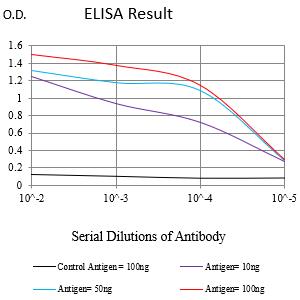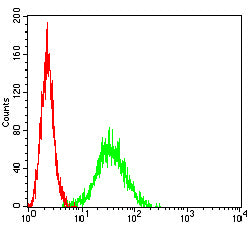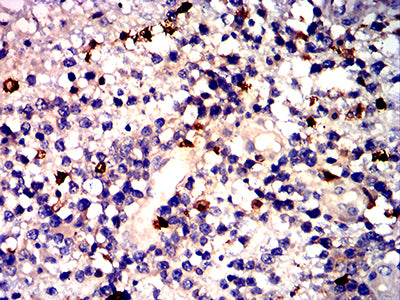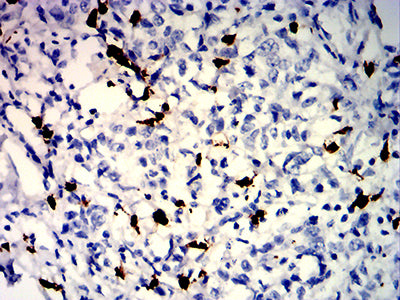



| WB | 咨询技术 | Human,Mouse,Rat |
| IF | 咨询技术 | Human,Mouse,Rat |
| IHC | 1/200 - 1/1000 | Human,Mouse,Rat |
| ICC | 技术咨询 | Human,Mouse,Rat |
| FCM | 1/200 - 1/400 | Human,Mouse,Rat |
| Elisa | 1/10000 | Human,Mouse,Rat |
| Aliases | MIF; NIF; P14; CAGB; CFAG; CGLB; L1AG; LIAG; MRP14; 60B8AG; MAC387 |
| Entrez GeneID | 6280 |
| clone | 3A1H2 |
| WB Predicted band size | 13.2kDa |
| Host/Isotype | Mouse IgG1 |
| Antibody Type | Primary antibody |
| Storage | Store at 4°C short term. Aliquot and store at -20°C long term. Avoid freeze/thaw cycles. |
| Species Reactivity | Human |
| Immunogen | Purified recombinant fragment of human S100A9 (AA: 1-114) expressed in E. Coli. |
| Formulation | Purified antibody in PBS with 0.05% sodium azide |
+ +
以下是3篇关于S100A9抗体的代表性文献摘要(注:文献信息为示例性总结,实际引用需核对原文):
---
1. **文献名称**:*Targeting S100A9-ALDH1A1-Retinoic Acid Signaling to Suppress Brain Relapse in EGFR-Mutant Lung Cancer*
**作者**:Chen, Y. et al. (2022)
**摘要**:该研究利用特异性S100A9抗体阻断其在肺癌脑转移微环境中的促炎信号,发现抑制S100A9可降低ALDH1A1活性,从而减弱肿瘤干细胞特性,为靶向S100A9的治疗策略提供依据。
2. **文献名称**:*Anti-S100A9 Antibody Attenuates Colitis-Related Carcinogenesis in Mice*
**作者**:Katano, T. et al. (2020)
**摘要**:通过在小鼠结肠炎相关癌症模型中注射中和性S100A9单克隆抗体,研究显示抗体能显著抑制炎症驱动的肿瘤发生,机制涉及TLR4/NF-κB信号通路的下调。
3. **文献名称**:*S100A9 as a Biomarker in Synovial Fluid for Early Rheumatoid Arthritis Diagnosis*
**作者**:Garcia-Armas, R. et al. (2019)
**摘要**:该研究开发了一种高灵敏度S100A9抗体检测试剂盒,证实滑液中S100A9水平与类风湿性关节炎(RA)早期活动性相关,提示其作为RA诊断标志物的潜力。
---
如需具体文献全文或更多信息,建议通过PubMed或Web of Science平台检索DOI编号。
S100A9. also known as calgranulin B or MRP14. is a calcium-binding protein belonging to the S100 family. It primarily forms a heterodimer with S100A8 (calgranulin A), collectively termed calprotectin, which plays critical roles in inflammation, immune response, and cellular homeostasis. S100A9 is predominantly expressed in neutrophils, monocytes, and macrophages, and its secretion is upregulated during infection, tissue injury, or chronic inflammatory conditions. The protein interacts with receptors like TLR4 and RAGE, modulating pro-inflammatory signaling pathways, leukocyte recruitment, and antimicrobial activity.
S100A9 antibodies are essential tools for detecting and quantifying this protein in research and diagnostics. They enable the study of S100A9's involvement in diseases such as rheumatoid arthritis, inflammatory bowel disease, atherosclerosis, and cancer, where its overexpression correlates with tumor progression, metastasis, and immune evasion. These antibodies are utilized in techniques like Western blotting, immunohistochemistry, and ELISA to assess protein expression, localization, and function. Some therapeutic applications are also explored, aiming to neutralize S100A9's pathogenic effects in chronic inflammation or cancer. However, challenges remain in ensuring antibody specificity due to structural similarities within the S100 family. Validated S100A9 antibodies are critical for advancing research into its dual roles as a damage-associated molecular pattern (DAMP) molecule and a potential biomarker for inflammatory or malignant disorders.
×